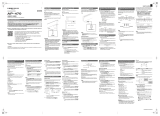
E-1
English
Contents
General Guide ................................... E-2
FUNCTION Button...................................................... E-3
Saving Settings and Using Operation Lock ................ E-3
Playing with Different Tones ........... E-4
Selecting and Playing a Tone..................................... E-4
To adjust the brilliance of a tone................................. E-5
Layering Two Tones ................................................... E-6
Using Effects............................................................... E-7
Using the Digital Piano’s Pedals................................. E-7
Using the Metronome ................................................. E-8
Playing a Piano Duet .................................................. E-9
Playing Back Built-in Songs .......... E-10
Playing Back All of the Built-in Songs....................... E-10
Playing Back a Specific Music Library Song............. E-10
Practicing with a Music Library Song........................ E-11
Recording and Play Back............... E-12
Tracks....................................................................... E-12
To record to a specific track of a song...................... E-13
To record to one track of a song while listening
to the playback of the other track.............................. E-14
Playing Back from Digital Piano Memory.................. E-14
Deleting Recorded Data ........................................... E-15
Configuring Settings with the
Keyboard ......................................... E-16
To configure settings with the keyboard ................... E-16
Keyboard Keys Used for Configuring Settings ......... E-17
Parameter List .......................................................... E-18
Reverb................................................................... E-18
Chorus................................................................... E-18
Tone selection....................................................... E-18
Brilliance (BRILLIANCE) ....................................... E-18
Layer balance........................................................ E-18
Tempo (TEMPO)................................................... E-18
Song select (SONG SELECT)............................... E-18
Song volume (SONG VOLUME) ........................... E-18
Metronome volume (METRONOME VOLUME) .... E-18
Metronome beat (METRONOME BEAT)............... E-18
Keyboard key (Transpose) .................................... E-19
Keyboard tuning (Tuning)...................................... E-19
Octave shift ........................................................... E-19
Temperament (TEMPERAMENT)......................... E-19
Temperament select
(TEMPERAMENT SELECT) ................................. E-19
Temperament Base note (BASE NOTE)............... E-19
Touch response (TOUCH RESPONSE) ............... E-19
USB device mode (USB DEVICE MODE).............E-20
Send channel.........................................................E-20
Local control ..........................................................E-20
Card menu (CARD MENU)....................................E-20
Operation tone....................................................... E-20
Back up..................................................................E-20
Operation lock........................................................E-20
Using a Memory Card ..................... E-21
Loading and Removing a Memory Card ...................E-22
Formatting a Memory Card .......................................E-22
Saving a Recorded Song to a Memory Card ............E-23
Loading Song Data from a Memory Card into
Digital Piano Memory................................................E-23
Deleting Memory Card Data......................................E-24
Simple Play Back of a Song on a Memory Card ....... E-25
Saving Data to Digital Piano Memory
(Internal Area) Instead of a Memory Card.................E-25
Error Indicators..........................................................E-26
Connecting to a Computer............. E-28
Minimum Computer System Requirements ..............E-28
Connecting the Digital Piano to Your Computer .......E-28
Using MIDI ................................................................E-29
Transferring Song Data with a Computer..................E-29
Reference......................................... E-39
Troubleshooting ........................................................E-39
Product Specifications............................................... E-40
Operating Precautions ..............................................E-41
Appendix............................................ A-1
Tone List ..................................................................... A-1
Song List .....................................................................A-1
MIDI Implementation Chart
Company and product names used in this manual may
be registered trademarks of others.
Getting Ready ........................................................................................................E-32
Assembling the Stand ............................................ E-32
Using the Keyboard Cover Spacer......................... E-36
Magnetism.............................................................. E-37
Power Outlet........................................................... E-37
Connecting Headphones.........................................E-37
Connecting Audio Equipment or an Amplifier .........E-38
Bundled and Optional Accessories .........................E-38
PX830_01_eTOC.fm 1 ページ 2009年7月16日 木曜日 午後12時39分






















